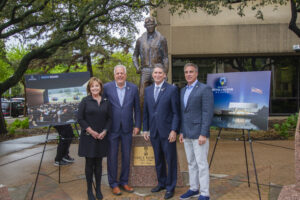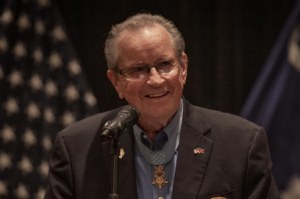Sergeant First Class, U.S. Army, Operation Inherent Resolve
Thomas “Patrick” Payne is a U.S. Army Ranger assigned to Special Operations Command who took part in a daring mission to rescue hostages at an Islamic State (ISIS) prison near Hawijah, Iraq, on October 22, 2015. Along with other American and Kurdish commandos, Sergeant First Class Payne flew in CH-47 Chinook helicopters to the town to liberate approximately 70 Iraqi prisoners held there. Though Payne and the other Americans were there to support the Kurdish rescue effort, ISIS resistance at the prison drew the American special forces members into the growing battle. Payne helped save pinned down Kurdish commandos and twice entered a damaged, burning building to ensure every hostage was freed. On September 11, 2020, Sergeant Major Thomas Payne was awarded the Medal of Honor for his actions at Hawijah.

- Branch of Service: US Army
- Conflict: Global War on Terror, Operation Inherent Resolve
- Action Rank: Sergeant First Class
- Unit: U.S. Army Special Operations Command
- Action Date: October 22, 2015
- Medal of Honor Awarded: September 11, 2020
- Presenter: President Donald Trump
Early Life
Thomas Payne is from the South Carolina towns of Batesburg-Leesville and Lugoff. In 2002, Payne joined the U.S. Army and later became an Army Ranger with the 75th Infantry Regiment (Ranger) in 2003. Payne served as a sniper and team leader in the 1st Battalion, 75th Ranger Regiment until late 2007 when he was assigned to the U.S. Army Special Operations Command. Payne has deployed multiple times to combat zones and received a Purple Heart in 2010 from a wound he sustained in Afghanistan from a grenade. Overcoming his serious combat wounds, Payne, along with his teammate Master Sergeant Kevin Foutz, won the Army’s Best Ranger Competition as a representative of U.S. Army Special Operations Command in 2012.

The Prison Rescue
Throughout 2014, ISIS expanded its control over increasing amounts of northern Iraq. In regions where they seized control, ISIS leadership was quick to execute or imprison anyone who was a threat to their rule or hardline ideology. Around the town of Hawijah, located in the Kirkuk province of Iraq, ISIS had packed more than 70 people into a two-building prison. The prisoners were fed very little and forced to watch videotaped ISIS beheadings on nearby TVs. The Kurdish Regional Government received intelligence that the 70 prisoners, among them possible Kurdish fighters, were soon to be executed by ISIS forces. The threat was serious, as Iraqi media had filed numerous reports of ISIS carrying out just these kinds of executions in Hawijah.
Given the urgency of the situation, a pre-dawn raid was planned for October 22, 2015. This hostage-rescue mission was to be led by Kurdish peshmerga commandos and supported by the U.S. Special Forces Command. Two members of the American contingent were Master Sergeant Joshua L. Wheeler and then Sergeant First Class Thomas Payne.
After flying in on American CH-47 helicopters, the allied assault force reached the prison compound. The initial Kurdish efforts to breach the compound’s outer wall with explosives failed, and ISIS guards began to return fire. With the fight quickly escalating and the threat to the prisoners growing, Wheeler, Payne and the rest of the American team climbed over a wall and entered the prison.
Almost immediately, Wheeler was struck and killed by ISIS gunfire. Continuing forth, Payne and the rest of the team cleared one of the two buildings, cut the locks on the prison doors, and freed almost 40 hostages before rushing to an intense firefight that had begun in the other building. With the first building cleared, Payne and other U.S. Army soldiers moved to assist Kurdish commandoes pinned down by ISIS gunfire. Payne and his team climbed up a ladder and onto a roof as rounds flew overhead. From this rooftop position, Payne and his team engaged the enemy with small-arms and grenades. Seeking to counter this new threat, ISIS fighters tried to collapse the roof by detonating explosive vests in the room below. Payne then moved off the roof and through a fortified door of a burning building with prisoners trapped inside. Payne and a Kurdish commando braved the smoke and fire to cut the doors open with bolt-cutters and rescued 30 more hostages before the building collapsed from the fire and damage taken from enemy gunfire
“…Once you’re able to control your fear, that’s the bridge to personal courage and personal courage is contagious on the battlefield.”
Sgt. Major Thomas P. Payne
Despite the danger of the building’s possible collapse, Payne re-entered it two more times to ensure that every possible person had been rescued. The American and Kurdish forces were surprised to find so many more prisoners than initial intelligence had indicated. Instead of finding 20 Kurdish Peshmerga fighters, they freed approximately 70 hostages, including more than 20 members of the Iraqi Security Forces. Freeing almost 70 hostages from certain death, the October 22, 2015 action was one of the largest hostage rescues in Special Operations history.
For his leadership and actions on October 22, 2015, Sergeant Major Thomas P. Payne received the Medal of Honor on September 11, 2020.
Medal of Honor Citation

For conspicuous gallantry and intrepidity at the risk of his life above and beyond the call of duty:
Sergeant First Class Thomas P. Payne distinguished himself by conspicuous gallantry and intrepidity, above and beyond the call of duty, on October 22, 2015, during a daring nighttime hostage rescue in Kirkuk Province, Iraq, in support of Operation INHERENT RESOLVE. Sergeant Payne led a combined assault team charged with clearing one of two buildings known to house the hostages. With speed, audacity, and courage, he led his team as they quickly cleared the assigned building, liberating 38 hostages. Upon hearing a request for additional assaulters to assist with clearing the other building, Sergeant Payne, on his own initiative, left his secured position, exposing himself to enemy fire as he bounded across the compound to the other building from which entrenched enemy forces were engaging his comrades. Sergeant Payne climbed a ladder to the building’s roof, which was partially engulfed in flames, and engaged enemy fighters below with grenades and small arms fire. He then moved back to ground level to engage the enemy forces through a breach hole in the west side of the building. Knowing time was running out for the hostages trapped inside the burning building, Sergeant Payne moved to the main entrance, where heavy enemy fire had thwarted previous attempts to enter. He knowingly risked his own life by bravely entering the building under intense enemy fire, enduring smoke, heat, and flames to identify the armored door imprisoning the hostages. Upon exiting, Sergeant Payne exchanged his rifle for bolt cutters, and again entered the building, ignoring the enemy rounds impacting the walls around him as he cut the locks on a complex locking mechanism. His courageous actions motivated the coalition assault team members to enter the breach and assist with cutting the locks. After exiting to catch his breath, he reentered the building to make the final lock cuts, freeing 37 hostages. Sergeant Payne then facilitated the evacuation of the hostages, even though ordered to evacuate the collapsing building himself, which was now structurally unsound due to the fire. Sergeant Payne then reentered the burning building one last time to ensure everyone had been evacuated. He consciously exposed himself to enemy automatic gunfire each time he entered the building. His extraordinary heroism and selfless actions were key to liberating 75 hostages during a contested rescue mission that resulted in 20 enemies killed in action. Sergeant First Class Payne’s gallantry under fire and uncommon valor are in keeping with the highest traditions of military service and reflect great credit upon himself, the United States Special Operations Command, and the United States Army.
Patrick Payne Links
Sergeant Major Thomas P. Payne: Medal of Honor (U.S. Army)
President Donald J. Trump to Award the Medal of Honor
Congratulations To Msg Kevin Foutz And Sfc Thomas Payne
ISIS Captives Say They Faced Blade as Rescue Came (New York Times)







